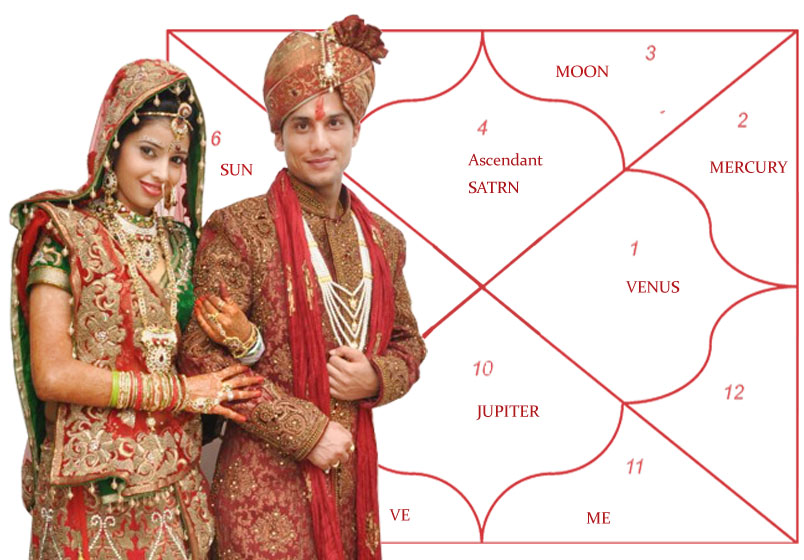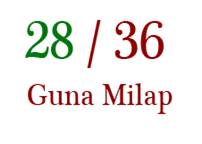Synastry of astrology (Guna Milap) explained
The birth-chart is the map of an individual’s past accumulated karma, and Guna Milap a measure of Karmic compatibility. It entails compatibility matching of the 8 important astrological categories, (or “Kootas”), comprising of 36 qualities, or points, (known as “Gunas,”) to find the match that compliments the individual the best.
Zotality uses the 2000 years old, time-tested principals of the, Synastry of astro-compatibility matching (Guna Milap) on all its platforms:
- Zo Match – karmic-astrology based social discovery & dating platform
- Kundali Matrimony – karmic-astrology based matrimonial destination for those, Indians, who are serious about finding themselves a spouse
- The proposed karmic-astrology and interpersonal relationships based 24/7 holistic astro guidance platform
Guna Milap score (or ZoScore, on our platforms) is indicative of the amount of effort required to enjoy each other’s company. The higher the score, the less would be the effort needed to enjoy each other’s company.
Guna Milap score (ZoScore) evaluates the energy levels, attitudes, and interactive skills that the two individuals may bring to the particular interaction or relationship. It is a measure of compatibility of the relationship and not its longevity, which would require a comprehensive study of both birth-charts.
Guna Milap analysis is not a generic sun-sign compatibility analysis. It is highly customized and birth-chart driven, and requires both the users’ birth – date, time, and place – information.
The Compatibility matching of 8 astrological-categories comprising of 36 astrological-points, or astro-qualities is known as “Ashta Koota Guna Milap” or simply “Guna Milap” in India)
Caste (Varna) Category – Up to 1 point (Guna) is allotted for this category (Koota)
The Caste (Varna) compatibility category is representative of issues related to the ego, and pride between the two individuals. Varna means caste and, because the feminine energy is more flexible and receptive than the masculine, it is advisable for a woman to be of the higher caste.
Note: An individual categorized as “Brahmin” caste (Varna) is not necessarily any more or less Brahmin than another categorized as “Kshatriya” caste. The Caste (Varna) classification, therefore, measures compatibility only and is not indicative of the actual caste of the person.
Control (Vashya) Category – Up to 2 points (Gunas) are allotted for the Vashya category (Koota)
Vashya literally means control. The Control (Vashya) compatibility category indicates who between the two individuals will have more control. It evaluates the intensity of mutual affection, and attraction due to respect and liking for each-other`s views and opinions. Mutual attraction and liking for each other’s views and opinions can create a strong bond between the individuals and help them overcome their general differences to an extent.
Star (Tara) Category – Up to 3 points (Gunas) are allotted for this category (Koota)
Tara literally means “Star” and the Star compatibility category represents receptivity of one partner to accept what the other has to offer, and evaluates the well-being of the two individuals on that basis.
Source (Yoni) Category – Up to 4 points (Gunas) are allotted for the Yoni category (Koota)
Yoni implies “source” or “being.” It can also be viewed as the female sexual organ, representing the source of life. Source (Yoni) compatibility category defines how the individuals will react to each other during extreme stress or very intense situations including, but not limited to, during sex. Since, each constellation (Nakshatra) has an animal symbol; Yoni (Source), therefore, is the sexual organ of that animal. In times of extreme stress or during intense, passionate, and forceful situations animals tend to fall back on their instinctive nature, depicted by the animal symbol of their constellation (Nakshatra). Source (Yoni) category is also indicative of the strength of bonding and contentment that stressful and intense situation including, and if applicable, sexual contact may bring the two individuals.
Planetary-Friendship (Graha Maitri) Category – Up to 5 points (Gunas) are allotted for this category (Koota)
“Graha” means planet and “Maitri” means friendship. The Graha Maitri compatibility category therefore means “planetary-friendship” category and it evaluates a bunch of criteria, essential for compatibility and a loving, enjoyable, fulfilling, and rewarding time together. The planetary-friendship category matches the outlooks, aims and objectives, levels of wisdom and intellect, and as well as the spiritual aspects of personalities, and natures of the individuals being matched.
Species or Race (Gana) Category – Up to 6 points (Gunas) are allotted for this category (Koota)
“Gana” in this context implies race or, even, species, which are of the three types, the (1) divine (Deva) category which are calm, kind, polite and steadfast, and stand on an even keel; (2) human (Manushya) category are innovative, and hard working and (3) demon (Rakshasa) category are explosive, unpredictable, and eccentric. The race compatibility category, therefore, evaluates the level of general adaptability and natural rapport between the two individuals. It indicates the unpredictability, excitability, explosiveness, and volatility of the relationship by matching temperamental characteristics between them. It measures, to an extent, the possibility of happiness and contentment in the relationship. Individuals from the same race or species will generally adapt to one another more readily than those of different or opposing species or race.
Note: An individual categorized under the “Deva” (divine) race is not necessarily any more or less divine or demonic than another categorized within the “Rakshasa” (demon) race. The race or species (Gana) classification, therefore, measures compatibility only and is in no way indicative of the character of the individual.
Moon (Bha) Category (Koota) – Up to 7 points (Gunas) are allotted for this particular category (Koota)
The moon-category (Bha-koota) compatibility indicates the relative position of the moon within the main zodiac. If the girl’s-boy’s moons are located respectively at 2nd-12th, 5th-9th and 6th-8th to each other, the points then allotted is zero out of a maximum of 7 points. If the location of the two moons is different, then the points allotted are 7 out of a maximum of 7 points. This particular blemish (Dosha) can affect intimacy between the individuals. A 6-8 relationship between the moons of the individuals may cause excessive arguments, discord, and abrupt changes in their lives. A 2-12 relationship between the two moons may cause feelings of shortcomings and problems, and delays in having children; and a 5-9 relationship may result in excessive competitiveness and an insatiable urge to be better than, and out-do, the other! This particular category is also indicative of the growth and welfare of family, birth of children, and family interaction.
Exception (only if applicable): If lords of the moon signs (Rashi) of both individuals are friends, the moon-category (Bha-koota) blemish is then removed.
Pulse (Pulse) Category – Up to 8 points (Gunas) are allotted for this category (Koota)
The Pulse (Nadi) compatibility category sheds light on the health of progeny and genetic compatibility of the two individuals. It represents the physical health and general wellness of the individuals – by evaluating the nature of the faults in the life-forces, or constitutions, defined by the three imbalances (Doshas); namely Kapha, Vata and Pitta; that shape the personality by affecting physiology – as detailed in India’s holistic and classical system of medicine called Ayurveda. This compatibility-category requires difference and diversity for an agreement or compatibility. If both the individuals, being matched, belong to the same class of imbalance, then that particular imbalance or fault is reinforced to the detriment of both. The diversity of faults and imbalances (Doshas), therefore, will help minimize the effect of the imbalance in the relationship.
Exception (if applicable): The Pulse blemish (Nadi Dosha) however is canceled if both individuals are born in the same moon sign (Rashi), under different constellation (Nakshatra), and the constellation of the male is situated before the female’s.
NOTE: If Gun Milap results are causing problems in your relationship, you may either want to consult your astrologer or one of the qualified astrologers (Jyotishis) at Zotality.



